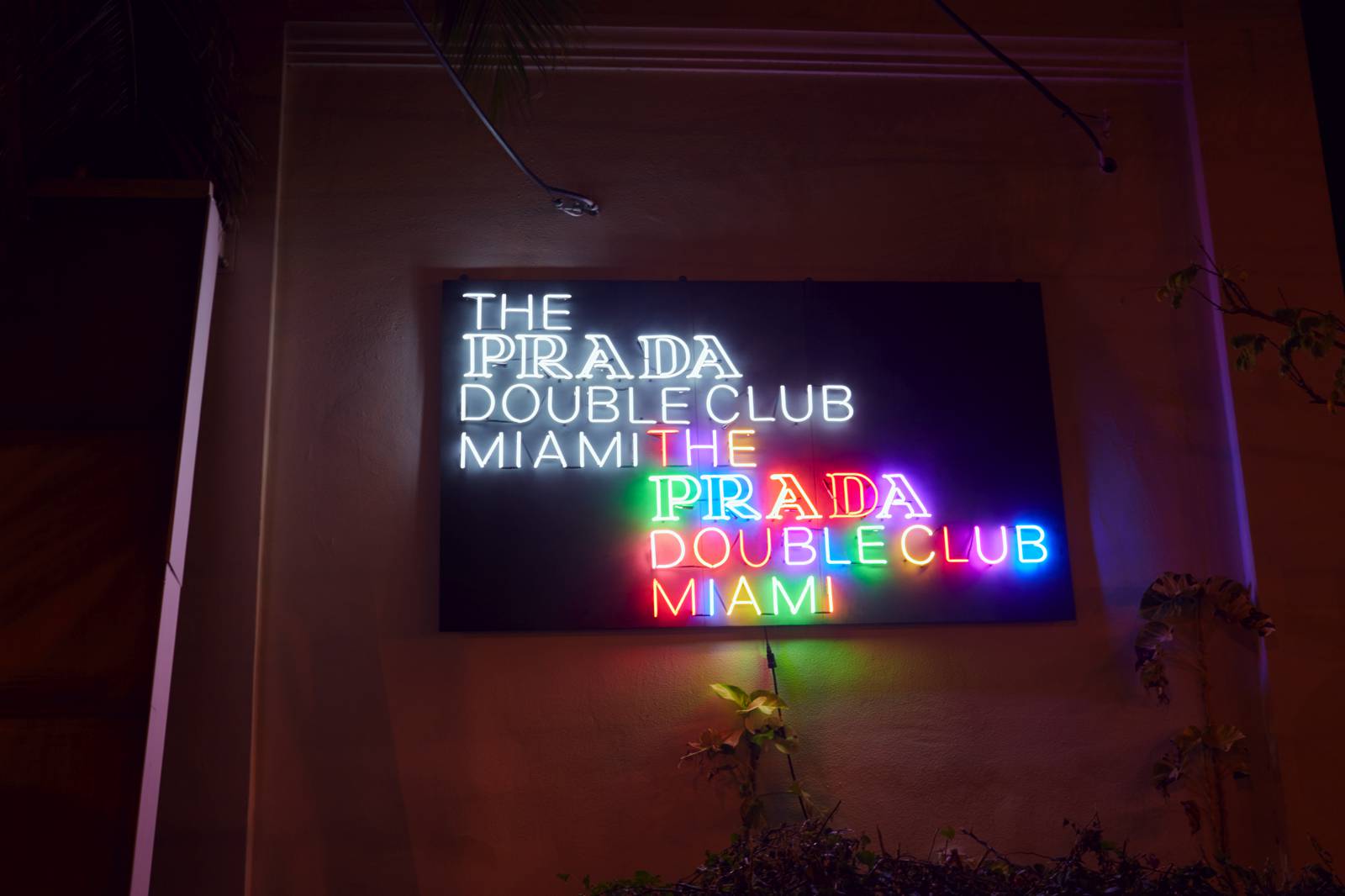
Virgil Abloh, J.W. Anderson, Diplo e Ricky Martin erano tutti presenti al progetto di partito di Carsten Höller
Benzoino Luccello
Se fossi a Londra intorno al 2008, potresti ricordare Il Doppio Club: un incongruo pop-up a tema congolese, ospitato in un magazzino del nord di Londra. Creato dall'artista Carsten Höller e bizzarramente sponsorizzato da Prada, il club / bar / ristorante temporaneo ha attratto celebrità, modaisti e club per oltre otto mesi. Probabilmente passerà alla storia come la più eccitante esperienza della vita notturna mai vista nella capitale.

L'EVENTO DI APERTURA DI MIAMI DOPPIO CLUB DI PRADA. FOTO: PIETRO BJORK
Quasi un decennio più tardi, Il Doppio Club è riportato in vita per la sedicesima edizione di Arte Basel Miami. Per soli tre giorni, questa seconda iterazione dell'installazione artistica esperienziale ha preso il sopravvento in uno studio cinematografico degli anni '20 con un'imponente line-up, titolata dalla Principessa Nokia, Metodo Uomo e la Madonna Nera. È stato lanciato con una prestazione di Wyclef Jean, che ha radunato Miuccia Prada, Hans-Ulrich Obrist, Chloe Saggio e Ricky Martin nel suo giardino tropicale illuminato al neon.
Il Prada Doppio Club Miami - in contrasto con la sua edizione originale di Londra - ha una divisione estetica, tra monocromatico e iper-policromatico. Mentre lo spazio esterno sabbioso e il suo palapa bar sono illuminati da neon colorati perfettamente proporzionati, la sezione interna sembra di entrare in un film di Tim Burton - nero, bianco e nient'altro consentito. "Prendo particolare attenzione ai dettagli", spiega Höller, che aveva incaricato i buttafuori di confiscare le cannucce colorate all'ingresso del secondo spazio, per preservare la sua identità estetica.

VIRGIL ABLOH. FOTO: GETTY
L'artista tedesco nato in Belgio è noto per la natura interattiva del suo lavoro - spesso associato al movimento dell'estetica relazionale - in cui la percezione e il processo decisionale sono centrali. Per il suo sondaggio presso la Hayward Galleria nel 2015, i visitatori sono stati confrontati con una serie di scelte: tra la porta A e la porta B per entrare nella galleria; inghiottire una pillola da una pila sul pavimento o no (pensa Il Matrice blu e rosso); è stato buttato giù dal museo da una delle due gigantesche diapositive attaccate alla facciata della Rivasud (che ha fatto il suo acclamato debutto alla Tate Moderno nel 2006). Lo stesso concetto si applica al club di Miami, dove le persone dovevano scegliere tra due contesti drasticamente contrastanti (sebbene fossero liberi di viaggiare da uno all'altro).
E mentre il "divertimento" gioca chiaramente un ruolo importante nel lavoro di Höller (è in qualche modo sconcertante pensare di essere stato addestrato come scienziato agricolo), Il Doppio Club va ben oltre il puro divertimento. È un viaggio in cui arte, design e musica coesistono.

"IL PRADA DOPPIO CLUB MIAMI", UN PROGETTO DI CARSTEN HÖLLER PRESENTATO DALLA FONDAZIONE PRADA MIAMI, 5-7 DICEMBRE 2017. FOTO: CASEY KELBAUGH CORTESIA FONDAZIONE PRADA
"A volte vengo a conoscere le culture attraverso la musica", ci dice Höller, indicando la line-up caraibica e sudamericana del palcoscenico all'aperto (un momento saliente del secondo giorno è stata una performance del locale, 7-pezzo Tallawah Mento Banda ). "Volevo celebrare queste comunità, che sono così centrali nel tessuto culturale di Miami", continua. Nel frattempo, la musica elettronica pesante ha dominato lo spazio al chiuso, grazie a spettacoli come Mimi Xu (conosciuto anche Coniglio Nebbioso) e il produttore di Chicago la Madonna Nera.
Allo stesso modo, nel 2008 a Londra, il dialogo tra culture occidentali e congolesi è stato al centro dell'attenzione. Höller (che divide il suo tempo tra la Svezia e il Ghana) ha viaggiato in Congo estensivamente negli ultimi 20 anni. Questo interesse, senza dubbio, fu alimentato dalla sua educazione in Belgio, la cui violenta eredità coloniale segnò profondamente il paese centro-africano. "Volevo adottare un approccio più positivistico", racconta Höller. "Il Congo è un posto enorme. Volevo celebrare quella cultura in tutta la sua vitalità e potenza. "

HANS ULRICH OBRIST E CARSTEN HÖLLER. FOTO: PIETRO BJORK
Ora, Arte Basel Miami - uno dei momenti più esclusivi dell'agenda culturale internazionale, in cui l'uno per cento affluisce da tutte le parti del mondo - non è esattamente l'ambiente ovvio per un autentico scambio culturale. Quindi, la diversità ha in qualche modo abbandonato l'agenda, a favore dell'esperienza esperienziale glamour e guidata dal marchio? "Tu hai l'intrinseca diversità di Miami, e in più la natura internazionale di Arte Basel", spiega l'artista. "Era una folla molto variegata, imballata dall'inizio alla fine."
Indipendentemente da ciò, Il Doppio Club sarà probabilmente ricordato come la cosa più bella che è successo a questa edizione di Arte Basel Miami. E, chissà, potrebbe anche creare un campo in una città vicino a te in futuro: "È certamente una possibilità", dice Höller, che ritiene che gran parte del suo lavoro possa essere concepito come un doppio club. Si spera che la prossima tappa duri abbastanza a lungo per segnare davvero la coscienza collettiva locale.

"IL PRADA DOPPIO CLUB MIAMI", UN PROGETTO DI CARSTEN HÖLLER PRESENTATO DALLA FONDAZIONE PRADA MIAMI, 5-7 DICEMBRE 2017. FOTO: CASEY KELBAUGH. CORTESIA FONDAZIONE PRADA
previously, suddenly related: Rem Casafresca

































